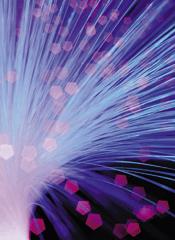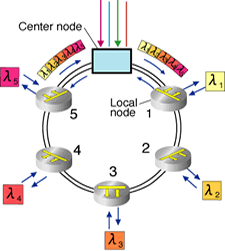 In the future, photonics will be able to do many of the same kinds of things as electronics such as amplifying, switching and processing signals. But the key difference is that photonic devices work with optical signals, not electrical signals. This has several advantages, the most important advantage is that photonics can be used to manipulate signals with very high bandwidth (high information content), far beyond the bandwidth limitations of electronics. It is expected that the amount of information carried on computer and telecommunications networks to continue to grow very rapidly into the future, so photonics will play an important role. In the future, photonics will be able to do many of the same kinds of things as electronics such as amplifying, switching and processing signals. But the key difference is that photonic devices work with optical signals, not electrical signals. This has several advantages, the most important advantage is that photonics can be used to manipulate signals with very high bandwidth (high information content), far beyond the bandwidth limitations of electronics. It is expected that the amount of information carried on computer and telecommunications networks to continue to grow very rapidly into the future, so photonics will play an important role.
However, most photonic devices (based on non-linear optical effects are still quite primitive in comparison to electronics. It is still early days. Many devices are still confined to research laboratories. The stage of development in photonics today is probably roughly equivalent to the vacuum tube used in the electronic systems of the 1940s.
Why use optical signals?
Optics is important because optical fiber cables can be used to transport large amounts of information over very long distances, much more effectively and cheaply than electrical cables or radio. The BT network in the UK alone contains more than 3.5 million kilometres of optical fiber, it is one of the richest optical fiber networks in the world and almost all of BT's long distance telecommunications traffic is carried over optical cables. In a joint venture with six of its partners, BT has recently created the largest pan European high speed network, comprising some 36,000 route kilometres of optical fibers, with points of presence in more than 200 cities across seven countries.
 The enormous bandwidth carrying capacity of optical fiber (potentially as great as 10 thousand billion bits per second - equal to about one million simultaneous TV channels) was recognised from the very earliest days of development of optical fiber, more than 30 years ago. However this huge potential capacity has yet to be realised. Today's networks still consist of electronic switches and routers interconnected by point to point optical transmission channels. So in practice, the amount of information that can be carried on one of these channels is not limited by the fiber, but by the information processing speed of the electronic equipment used at each end of the fiber link. The enormous bandwidth carrying capacity of optical fiber (potentially as great as 10 thousand billion bits per second - equal to about one million simultaneous TV channels) was recognised from the very earliest days of development of optical fiber, more than 30 years ago. However this huge potential capacity has yet to be realised. Today's networks still consist of electronic switches and routers interconnected by point to point optical transmission channels. So in practice, the amount of information that can be carried on one of these channels is not limited by the fiber, but by the information processing speed of the electronic equipment used at each end of the fiber link.
A way round this bottleneck is to carry several optical channels interconnecting several different electronic switching units - simultaneously on the same fiber link. There are two main approaches to doing this. One approach is to use wavelength division multiplexing (WDM) in which data signals on different optical carriers (i.e. different wavelengths, or colours) are combined together on a single fiber. WDM is already at an advanced stage of development, and point to point links with high aggregate capacity (as great as several hundred billion bits per second) can be deployed today using components and systems that are available commercially.
The other approach to increasing the capacity of fiber systems is to use optical time-division multiplexing (OTDM). OTDM is a method of carrying information on a single channel in the form of ultrashort optical pulses at very high rates - 100 Gbit/s and higher, beyond the envisaged speed limits of electronics. The underlying principle in OTDM is that many lower speed data channels, each transmitted in the form of extremely short optical pulses, are time interleaved to form a single high speed data stream. OTDM is currently viewed as a longer term solution because it relies on different, and much less mature, technologies. Many of the key components needed for OTDM are still confined to the research laboratory. However OTDM has some very important advantages for future photonic networks. Moreover, the two approaches WDM and OTDM are not incompatible, and in the future they will be used in combination to best utilise the fiber bandwidth.
So what is a Photonic Network?
 The basic approach used to create today's networks - electronic switches interconnected by optical point to point links, has the drawback that all of the information carried on a fiber must be processed and switched using the electronic equipment at the ends of each individual link. But since very often the bulk of the information is passing through in transit to some other network destination, this means that the electronic equipment has to be much bigger and more complex than is really necessary. The basic approach used to create today's networks - electronic switches interconnected by optical point to point links, has the drawback that all of the information carried on a fiber must be processed and switched using the electronic equipment at the ends of each individual link. But since very often the bulk of the information is passing through in transit to some other network destination, this means that the electronic equipment has to be much bigger and more complex than is really necessary.
But in a new approach currently being developed, data will be transmitted across the future photonic network entirely in the form of optical signals, without the need for big electronic switches. Photonic devices will be used to process and route the information in its optical form. This avoids the need continually to convert optical signals into electronic ones and back again. But even more important, systems based on photonic processing and routing will have the ability to handle much greater volumes of information and at lower cost.
One method of creating a photonic network is to route the optical signals according to their wavelength (e.g. one wavelength for London, another for Paris, and so on). This analogue optical approach to routing signals across a network is very simple, since it requires only passive components such as wavelength filters and gratings, but it has some serious practical limitations.
A more advanced approach is to carry the information across the network in the form of short high speed data packets, in effect a form of OTDM . The information is routed according to the destination address encoded into the packet. This digital optical approach is more akin to the way the routing is done today using electronics, but ultrafast photonic devices will be used instead. Not only will these signals be routed towards their destination at the speed of light, but they will be regenerated and processed in the optical domain too. It will be possible to transmit these signals over almost infinite distances through great numbers of network nodes without degradation. The digital optical approach thus overcomes the physical limitations of analogue routing, and the information speed of these signals is no longer limited by intermediate electronics. This looks like being a much more efficient and economic way of handling the massive amounts of information that will be carried over communications networks in the future. Moreover there have been recent important advances in the development of ultrafast optical devices that could open up these digital optical techniques to a much wider range of future applications, such as in local area networks and massive capacity routers.
The rapid proliferation of information technology in commerce, finance, education, health, government, security, and home information and entertainment, together with the ever increasing power of computers and data storage devices, is producing a massively increasing demand for network interconnection and traffic. This trend is expected to continue into the future. For example, it is predicted that the processing speed of high end work stations and mass market personal computers will increase by more than 1000 times in the next 10-15 years, and it is predicted that over the same time the traffic demand on core telecommunications networks will grow by at least 100 fold. Photonic networking techniques have the power to satisfy this explosive increase in demand at relatively low cost.
It is becoming increasingly likely that in the longer term, ultrafast photonic techniques, together with wavelength multiplexing, will be used in networks at all levels, from the transcontinental backbone to the desktop.
<-- Back to Future of Computers |

